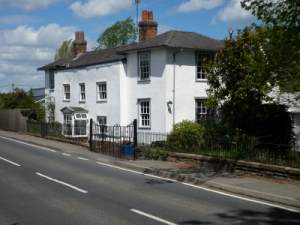Dr Francis Edward Camps
Pioneering Pathologist
Francis Edward Camps was
born on 28 June 1905 as the oldest son of a Dr Percy Camps, a
wealthy Surgeon and General Practitioner in Teddington and Alice
Redfern who was a drapers daughter from Ripley in Derbyshire.
Francis proved to be a clever young man who was educated at
Marlborough College and then followed his father into medicine by
studying at Guys Hospital Medical School.
When he qualified in 1928 he
stayed at Guys as a houseman in the team of pioneering
gastroenterologist Sir Arthur Hurst before moving to Chelmsford as a
General Practitioner.
The contacts made with nearby
Chelmsford and Essex Hospital led to some part time employment as a
pathologist and in 1930 Camps accepted a full time role which
allowed him to use the mortuary to conduct his own pathology.
His first pioneering work
came in relation to streptococcal infections at that time a serious
problem on maternity wards.
As his prominence as a
pathologist grew so did his relationship with Essex Constabulary and
the Essex Coroners for whom expert evidence was becoming more and
more important due to increased forensic capability and as the
population and criminals became more sophisticated.
Throughout his life Camps
displayed enormous energy allowing him to lecture at the London and
other major Hospitals, conduct pathology at Chelmsford and maintain
a surgery at Harley Street.
By 1963 he was appointed as
professor having led London Hospital to be preeminent in forensic
medicine and was accepted as the foremost pathologist having been
appointed as President of both the British Association in Forensic
Medicine and the British Academy of Forensic Sciences.
Not only was he a hard
taskmaster expecting his staff to achieve similarly high standards
to his own but he could be charming when the mood took him.
Despite his eminence in
medical pathology there is no doubt that his involvement in many
inquests and criminal cases brought Camps his fame and made him a
sought after figure for both defence and prosecution.
The first big case to bring
Camps name to national attention was the trial of John Reginald
Halliday Christie - the monster of Rillington Place. Christie had
already murdered several women and given false evidence to the
police resulting in the hanging of innocent flatmate Timothy Evans.
The murdering spree continued
until March 1935 when a man redecorating Christies old flat at
Rillington Place accidentally broke the plaster and found a human
body. The police broke down the wall and found three bodies. A
further examination of the garden revealed two more and the bath
house wall revealed two more.
Camps was called to examine
the scene and then to carry out a post-mortem. Camps pieced together
the skeletons in such an accurate way that they were all able to be
identified and linked to Christie.
This was a difficult job as
one skull alone was in over 100 pieces. At the trial the Judge
publicly thanked Camps for the painstaking and skilful way that he
had assembled the skeletons.
Christie was found guilty and
hung and in a strange twist Camps carried out the post mortem of
Christie after the hanging.
The next big case cemented
his place in the public mind as the pathologist was the trial of
Brian Donald Hume for the murder of Stanley Setty. The torso of
Setty was found in the marshes at Tillingham.
Click here
to read the story of the murder.
Camps post mortem established
the cause of death but also established that the body had been
dropped from a great height. The unexpected information moved the
Police investigation away from Southminster to local airfields which
provided the lead needed to arrest Hume.
A third case to reach
national interest was that of Sergeant Reginald Watters who was
found hanging in a British Army camp in Duisburg, West Germany in
1953. A local post Mortem showed that his death was consistent with
hanging and this verdict was returned at the inquest.
Sergeant Frederick
Emmett-Dunne quickly married Watters attractive young wife which
started rumours that the death was not suicide. Camps was asked to
conduct a second post-mortem a year after the death. He was able to
prove that death was caused by a martial arts style blow rather than
by hanging. This led to the arrest of Sergeant Emmett-Dunne who as
an ex commando was training in such death blows. At trial the
defendant admitted responsibility but claimed that he had acted in
self-defence and demonstrated his version of the incident. Dr Camps
was able to rebut this defence as scientifically implausible and
Emmett Dunne was convicted of murder.
 The
Limes, Purleigh where Camps lived for over 30 years
The
Limes, Purleigh where Camps lived for over 30 years
Camps had three wives. In
1930 he married Dulcie M Williams in Kensington. Dulcie was a nurse
who met Camps when he was a Junior Doctor at Guys Hospital. Despite
three children their marriage ended in divorce and Dulcie moved to
Canada.
In 1942 he marries Doctor
Mary Ross-Mackenzie who was nicknamed Bunny. Mary was a fellow
pathologist with whom Camps had two children. Camps and Mary moved
into the Limes at Purleigh, Essex in 1943 where Camps lived until
his death.
Sadly Mary died in 1971 after
nearly 30 years of marriage during which the Camps had featured in
the local life of Purleigh.
In 1972 Camps married for the
third time to Doctor Anne Elizabeth Robinson who was a toxicologist.
The marriage was only to last a few months before Camps died on 8
July 1972 at Chelmsford and Essex Hospital so ending is days in the
very mortuary where he had honed his skills and found fame.
His career brought fame and
money both of which he enjoyed to the full which is demonstrated by
his probate records listing his financial worth at death to be just
15,936 pounds.



